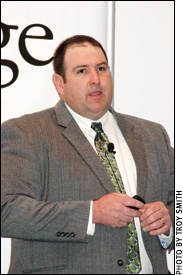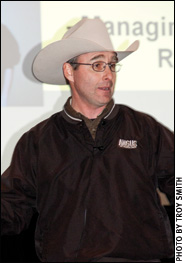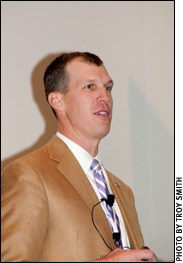Managing Market Risk
Cattlemen offer perspectives for what management practices best reduce risk in their respective operations.
by Troy Smith for Angus Productions Inc.
Back to the Angus Beef Bulletin EXTRADENVER (Feb. 2, 2011) — In times of market uncertainty and volatile input prices, most producers are interested in how they might better manage the risks inherent to the cattle business. In a session of the 18th Annual Cattlemen’s College®, conducted during the 2011 Cattle Industry Convention in Denver, three producers discussed risk management practices applied to their respective operations. In turn, they cited examples of strategies used to control costs, achieve respectable production and effectively market their products.
Trey Patterson
Leading off was Trey Patterson, COO for Padlock Ranches, which maintains cow-calf and yearling enterprises on properties in Montana and Wyoming. Calling replacement heifer development one of the most expensive parts of a cow-calf enterprise, Patterson explained how Padlock’s heifer development strategy is relatively low-cost and creates additional marketing opportunities.

Heifers saved as replacements are bred to calve on green grass in May, said Trey Patterson, Padlock Ranches. This is one of the ways Padlock Ranch tries to manage risk.
Patterson said heifers are grown to modest breeding weights, and more than the number actually needed for replacements are exposed once to artificial insemination (AI). The heifers are checked for pregnancy by ultrasound 45 days later.
“We let the heifers’ ability to conceive, after one round of AI, finish the selection process,” Patterson said. “The 35% to 40% that are open are then profitable to feed (to finish) and market through Country Natural Beef.”
The heifers saved as replacements are bred to calve on green grass in May. They’re not run through calving sheds and little labor is required when they are bred to Wagyu sires for calving ease. The program produces first-calf heifers that are more likely to rebreed on time and stay in the herd. And their first Wagyu-sired calves are economically grown to 700 pounds (lb.) in a backgrounding lot and sold at a premium.
“Contrary to what people might think, we’re not taking a hit on those calves,” Patterson offered. “Some years they make more money than calves out of cows bred to conventional bulls.”
Another profitable Padlock practice involves young cows that fail to rebreed within the defined spring breeding season. Those cows are then bred for fall calving and sold to a growing list of repeat buyers.
“Marketing is integrated into the entire system,” Patterson said. “We’re addressing costs and building a marketing plan at the same time.”
Dan Schiefelbein
The second speaker was Don Schiefelbein whose family owns 650 registered Angus cows in Minnesota and merchandises close to 300 Angus and Sim-Angus bulls each year. Schiefelbein Farms annually finishes about 5,000 cattle purchased from seedstock customers and buys an additional 1,500-2,000 head for placement in custom feedlots.

Feeding cattle from weaning to harvest in a barn represents a significant initial investment, but it significantly reduces labor requirements, eliminates the bedding otherwise required in Minnesota, and simplifies manure management, said Don Schiefelbein.
Calves fed at home are weaned into a confinement barn where they remain until ready for harvest. While a barn represents a significant initial investment, Schiefelbein said it significantly reduces labor requirements, eliminates the bedding otherwise required in Minnesota, and simplifies manure management.
With regard to risk management, Schiefelbein said the family takes a “Big Picture” perspective. In a “bull” market, they strive for significant profit potential. In a “bear" market, they look for a breakeven-plus opportunity and lock in the price.
“We buy feed cheap and sell cattle high,” Schiefelbein stated, noting the use of feedstuffs such as sweet corn silage, wet beet pulp, wet gluten feed, wet distillers’ grains and soy hulls. He said these feedstuffs are priced at 85% of the value of corn. Growing some of their own feed also serves as a risk management buffer.
“We always buy value-added cattle and we always sell value-added cattle — and always on a grid,” added Schiefelbein, explaining that cattle are source- and age-verified and targeted for non-hormone-treated or natural markets. “We create them for less and sell them for more."
Matt Perrier
The final presenter was Matt Perrier of Kansas-based Dalebanks Angus, a 400-cow seedstock operation marketing 200 bulls per year. Perrier said he and his father employ conservative stocking rates, prescribed burning and rotational grazing to enhance forage production and utilization on their Flint Hills ranch. They sell bulls at auction twice each year, but also sell some bulls and females at private treaty to diversify marketing.

Matt Perrier said he and his father employ conservative stocking rates, prescribed burning and rotational grazing to enhance forage production and utilization.
The operation includes some farm ground for production of grain and forage crops as well as forages raised for grazing. According to Perrier, the farming adds diversity to their feed resources and helps manage risk. Crops like forage radishes raised for grazing, along with cowpeas and oats, are an example of economical alternatives to developing replacement heifers on winter range and increasingly expensive commercial protein supplements.
Perrier said low-stress cattle handling helps lower risk by improving cattle health and the safety of both cattle and a limited labor force.
“With the information available today, genetics can help a cow-calf producer manage risk about as much as any other management tool,” said Perrier. “You can find high-accuracy seedstock and use them to manage risk in an operation. Seeking opportunities to sell in multiple markets lends flexibility. And I believe in operating in a modest environment to control costs. Most of all, I think producers should always be willing to change. Look for ways to reduce inputs and consider alternative markets.”
###
Editor’s Note: The above article was written under contract or by staff of Angus Productions Inc. (API). It may not be reprinted without express permission of API. To request reprint permision, contact the editor at 816-383-5200.
www.4cattlemen.com is an event coverage site provided by the editorial team at Angus Productions Inc. (API), publisher of the Angus Journal, the Angus Beef Bulletin, the Angus Beef Bulletin EXTRA and the Angus e-List. For questions about this site, to submit an article for our consideration, or to report a broken link, contact the editor at 816-383-5200; 3201 Frederick Ave., Saint Joseph, MO 64506.
API claims copyright to this web site as presented. We welcome educational venues and cattlemen to link to this site as a service to their audience.

